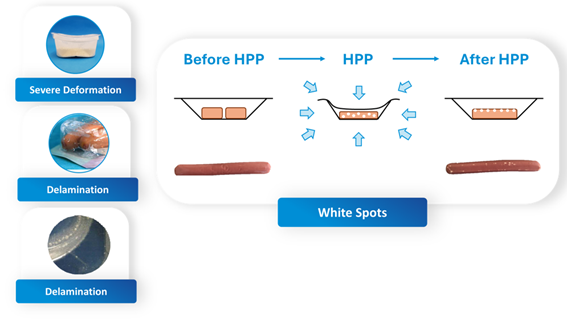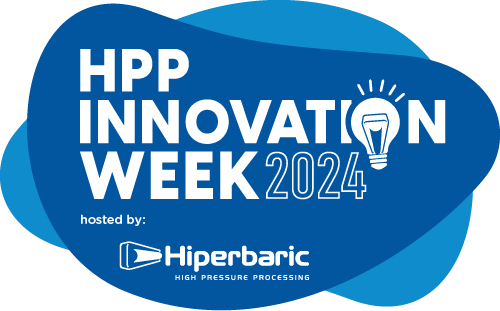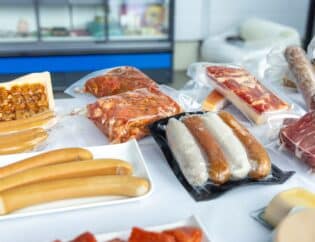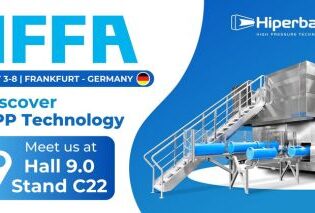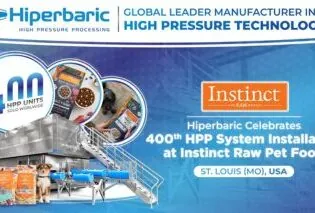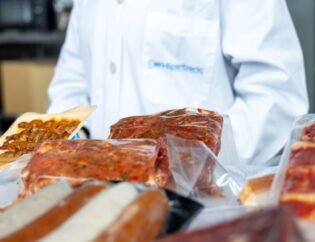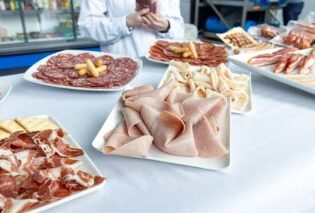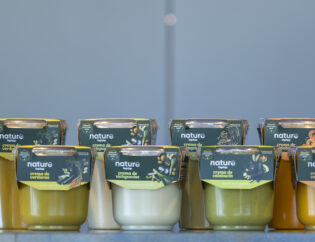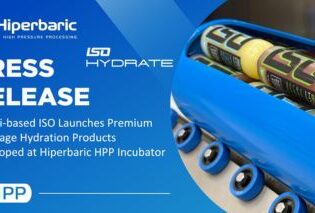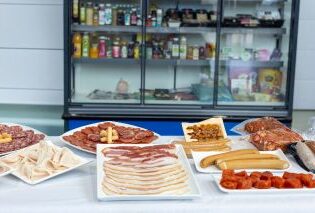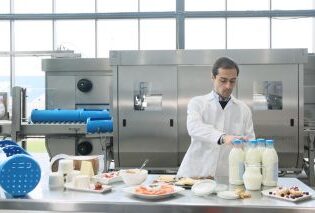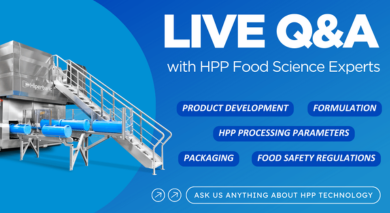
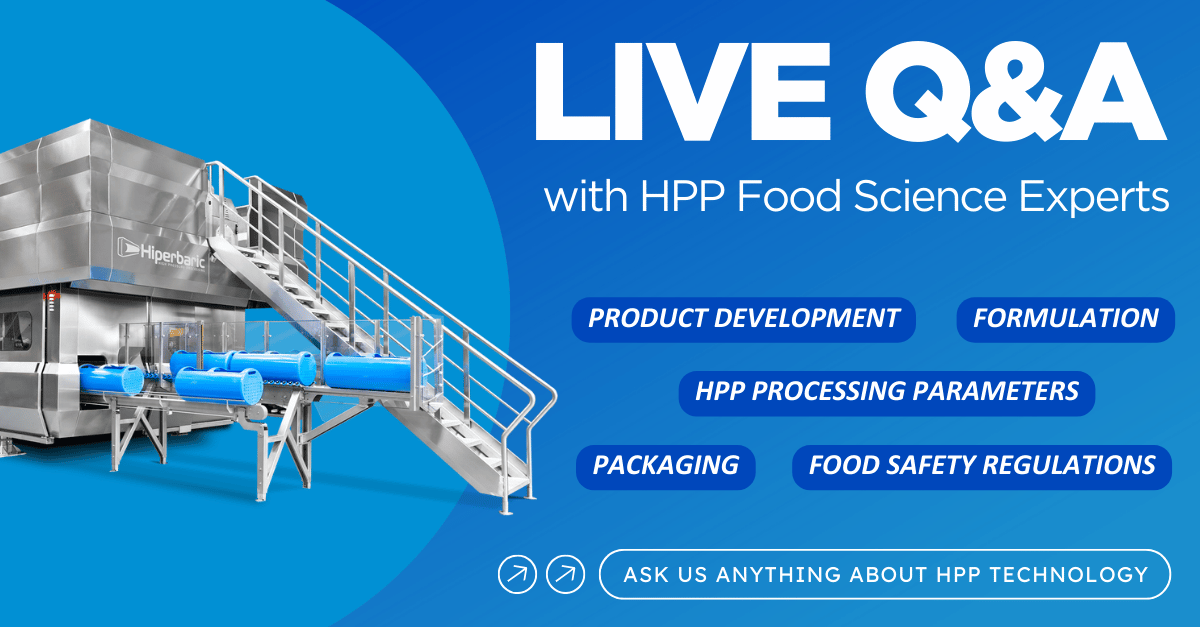
On July 25th, 2024, Hiperbaric hosted an interactive webinar featuring our esteemed HPP Food Science Experts. This Live Q&A session provided a unique opportunity for food industry professionals to gain valuable insights, best practices, and tailored recommendations directly from our team of specialists. Applications covered included guacamole, cut fruit, coconut water, raw and cooked meat products, oyster and lobster meat extraction, raw fish, cheeses, raw milk and RTE meals. Topics include product development, packaging and much more.
About HPP Food Science Applications Team & Incubator Program
On July 25th, 2024, Hiperbaric hosted an interactive webinar featuring our esteemed HPP Food Science Experts. This Live Q&A session provided a unique opportunity for food industry professionals to gain valuable insights, best practices, and tailored recommendations directly from our team of specialists.
The event was expertly moderated by Anthony Zapata, Business Development Manager at Hiperbaric, and featured our HPP Food Science experts:

The session addressed specific food science technical questions submitted by registrants, covering a wide range of topics related to HPP and its applications in the food industry.
At Hiperbaric, we’re proud to have a dedicated HPP Food Science Applications Team leading our innovative HPP Incubator Program. This program offers comprehensive food science support, including product development, HPP packaging optimization, processing parameter determination, food safety regulation guidance, and validation and shelf-life studies.
To facilitate hands-on experimentation and testing, we provide complimentary HPP testing facilities at our pilot plants in:
- Miami, FL, USA
- Burgos, Spain
- Shanghai, China.
Understanding High Pressure Processing (HPP)
High Pressure Processing, or HPP, is an innovative non-thermal food preservation technique that uses high levels of hydrostatic pressure (up to 6,000 bar or 87,000 psi) to inactivate foodborne pathogens and spoilage microorganisms. This method extends shelf life while maintaining the sensory and nutritional qualities of food products. HPP is widely applied in various food categories, including juices, dips, ready-to-eat meals, seafood, and meat products.
Featured Questions from Live Q&A Session
Why does HPP work in guacamole if this fruit is prone to browning?
HPP has proven to be a successful method of preservation for avocado products, it’s been demonstrated that HPP does reduce PPO activity after treatment by 50%. Untreated avocados and HPP-treated avocados will behave the same once they are exposed to air both turning brown.
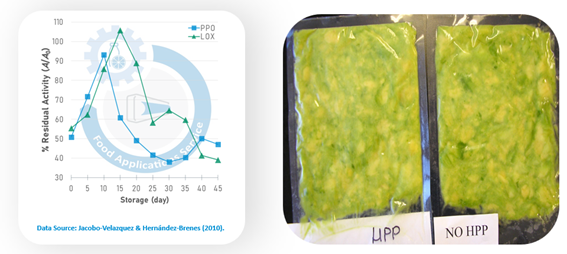
What is the limitation of processing whole fruit pieces under pressure?
HPP is generally not feasible to process whole or in pieces fruits. This is due to cellular modifications, specifically damage to the cell wall, which leads to the release of water and intracellular components. This release results in an undesirable appearance. A potential solution is to process the fruit while it’s submerged in its own juice. This method allows the juice to fill the pores when under pressure, thereby preserving the fruit’s structure.
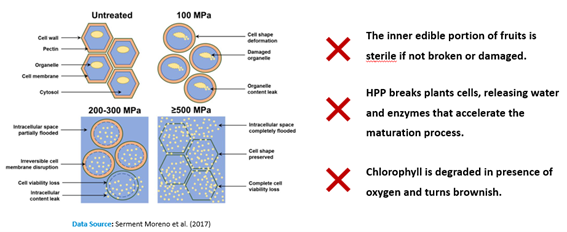
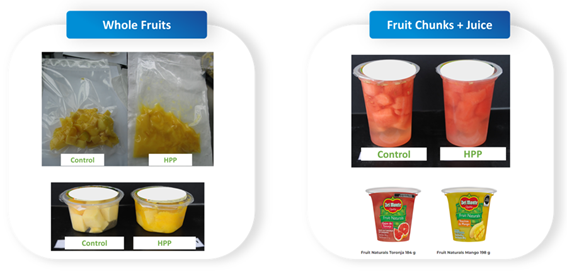
Is HPP practical to shuck clusters of rock oysters?
HPP can be a practical method for shucking clusters of rock oysters by utilizing high pressure to separate the shells. By applying pressures of 2,000 -3,000 bar for 60-100 seconds, oyster clusters separate with ease, allowing the meat to be shucked efficiently.
Can HPP-treated whole lobster claws and elbows be deshelled without breaking, and if so, how is the meat best extracted?
The meat separates from the shell because under pressure, it compresses much more than the shell itself. This difference in volume causes the meat to detach. However, it is still necessary to break the shell to retrieve the meat, because the shell remains intact. A common practice is to use compressed air to help expel the meat.
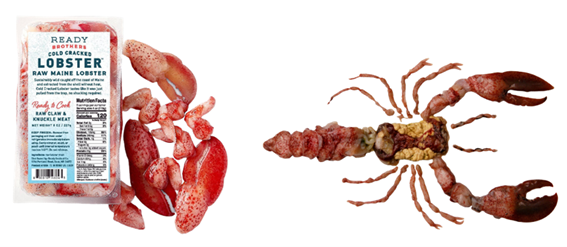
How does HPP impact cold brew coffee’s chemical composition, flavor profile, production methods, shelf life, and caffeine content, considering factors such as TDS levels, bean processing, aroma preservation, nitrogen flushing, and pressure-induced temperature changes?
The absence of heat in the brewing process of Cold Brew Coffee confers this beverage with unique flavor characteristics. Hence, HPP emerges as a promising tool to ensure safety and extend shelf life of CBC. Our study used a commercial ground blend of medium-roasted Arabica and Robusta beans. Total dissolved solids remained stable throughout the 90-day period studied, and the slight decrease observed was not significant, but it can be attributed to microbiological activity (not to HPP). Our work did not evaluate caffeine content, but others reported no changes. Similar findings were reported for aroma compounds. The effect of pressure-induced temperature changes is negligible because temperature would only rise around 18 °C or 64 °F for 3 min. Flushing nitrogen would not induce further changes with the application of HPP.
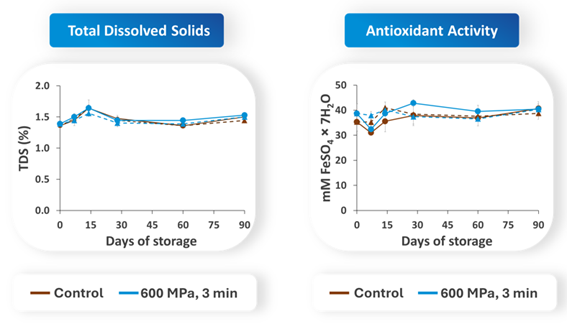
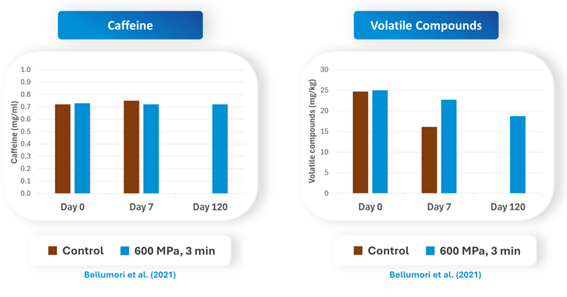
Does the rate of compression and decompression in HPP significantly affect microbial inactivation in treated products, and if so, to what extent?
There is a limited number of studies on this topic. Some research has found that rapid decompression increases the lethality to certain bacteria, while others have shown no significant differences between slow and fast rates. Given the available results, it is advisable to use rapid compression and decompression rates to enhance productivity.

Can HPP reduce/mitigate the oxidation process that causes color changes (pinkish) in coconut water?
The pink discoloration observed in coconut water after HPP is a consequence of an enzymatic reaction. The enzyme polyphenol oxidase remains active after HPP and oxidizes polyphenols present in coconut water. The oxidized polyphenols give the beverage its characteristic pinkish color. Lowering the pH of coconut water or flushing nitrogen in the bottles will delay this process.
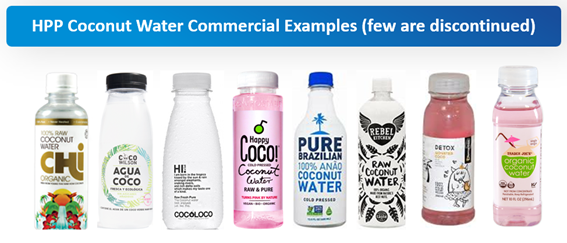
Since this is more of pasteurization alternative, how do you test the lethality given by this high pressure?
Thermal pasteurization is indeed very well established, and it is possible to estimate the lethality for a given time/temperature combination. However, HPP is a relatively new process, and more research is needed to establish the correlation. Although it is possible to check the scientific literature to find expected inactivation values, the most straightforward approach is by means of a challenge study. Specialized institutions can deliberately contaminate a food with a known concentration no microorganisms and subject it to HPP. The count difference before and after the process gives the inactivation figure. Hiperbaric collaborates with several universities and laboratories offering the service. Our HPP Academia Network can help you with this.
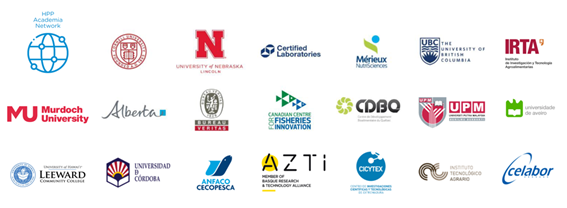
Are there HPP-resistant batch identification methods available, and what rapid tests can verify HPP effectiveness?
There are indeed pressure-sensitive inks that can be adhered to every single pack or to the carriers used to load the food products. Although they may not be able to state the exact value of applied pressure precisely, they can at least determine whether a batch has been subjected to pressure. Rapid verification tests have not been developed yet, so microbiological testing is still the most reliable method.
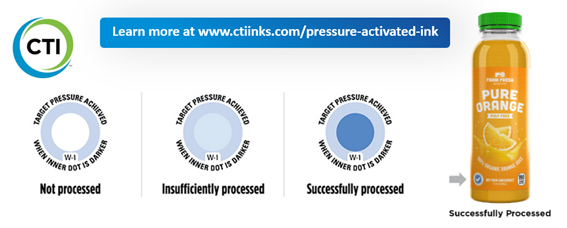
Can HPP extend shelf life for dairy products like paneer and milk-based sweets? If so, by how much?
HPP can help inactivate pertinent pathogens that could be present in dairy based products, depending on the pH value, the shelf life will be increased, if the pH is below 4.6, a shelf life of 90 days is expected under refrigerated conditions, and if the pH is higherit can be extended up to 45 days. For cheese processing, HPP can be applied either for fresh cheeses to help extend the product´s shelf life for 30-45 days, and for semi-hard cheeses to control L. monocytogenes.

Types of packaging materials suitable for HPP?
There is a vast list of packaging formats compatible with HPP, these are mainly characterized by being flexible and water resistant, so that they can withstand the HPP process. Because of this, almost all the packaging formats are plastic made. There are bottles, bags, tubs, cups, pouches, trays and kegs.
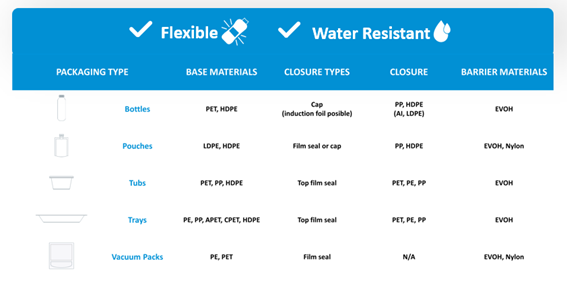
I processed some sausages with HPP, and some white dots appeared after processing? How can I prevent this effect from happening?
This effect is common when air is present inside the packaging. under pressure air dissolves inside the meat matrix, when the instant depressurization occurs, air comes out abruptly causing this effect in the meat. After certain hours the white dots disappear. Hence, we strongly suggest to vacuum pack the processed products, this will prevent this effect.
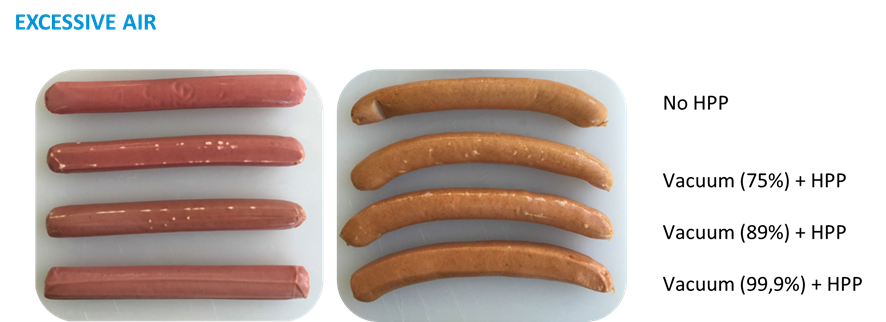
Can raw fish be processed with HPP? What are the limitations?
There are some fish species in which HPP is feasible, for instance, cod, mackerel, red mullet, sardines, gilt-head bream (“Dorada”), among others. Potential shelf-life: 15 -21 days for most fish species; there are some commercial examples of HPP cod with 45 days of shelf-life.
Limitations: red flesh fish, such as salmon and tuna, are particularly susceptible to pressure, getting a cooked appearance.

Can clean label antimicrobial agents replace post-lethal treatments such as HPP to kill Listeria monocytogenes on RTE meats?
A RTE meat product testing positive for L. monocytogenes is considered “adulterated”. Whereas antimicrobial agentes(such as celery powder) may prevent growth of the pathogen, HPP is the most straightforward to ensure anbsenceand to comply with USDA regulations.
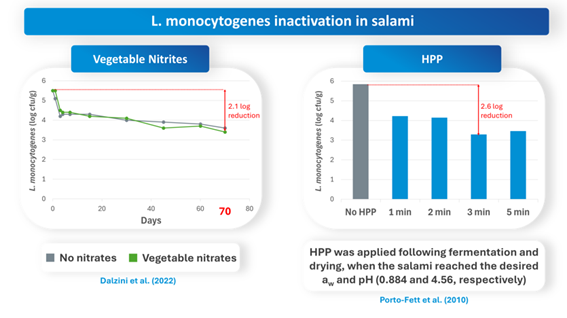
Is modified atmosphere packaging (MAP) suitable for ready meals?
No, because the gas is fully compressed during HPP. The sealing film comes into direct contact with the food during this process, which can cause staining. When the pressure is released, the gas expands again, potentially affecting the visual appearance of the meal.
